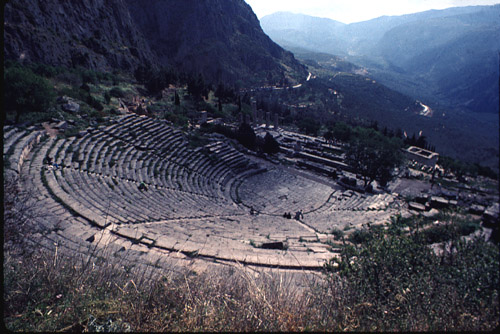
Old Cantankerous

Devices used by Menander to establish audience interaction are:
|
DEVICE
|
EXAMPLE
|
ANALYSIS
|
|
ASIDE
|
1) GETAS: "Then all that's left is to throw yourself in after them!" (583) 2) GETAS: "Just the job, if it's really rotten" (594) 3) SOSTRATOS: "A sensible man should never completely despair about anything. There's nothing that can't be achieved by concentration and hard work. I'm a living example of the truth! In one single day I've achieved a marriage that no one would have ever thought possible" (860-64). |
Menander uses asides for two things: to show a character's
true feelings, usually of anger; and to allow a character to speak directly
to the audience. Menander's asides link the audience to the characters
quickly and establish a relationship that will allow laughter later on.
|
|
MONOLOGUE
|
PAN: "Imagine, please, that the scene is set in Attica,
in fact at Phyle, and the shrine I'm coming from is one belonging to that
village. . . I've cast a spell on him, and he's fallen madly in love.
There, that's the outline. Details you'll see in due course, if you like--and
please do like. Ah! I think I see our lover coming with his friend: they're
busily discussing this very topic" (1-49).
|
Menander opens Old Cantankerous with a monologue
given by the god Pan directly to the audience, setting up the plot to
follow. The audience is forced to act as listener here and is hence passively
forced into the action--this opening soliloquy thereby embodies the definition
of audience interaction.
|
|
EAVESDROPPING
|
In the beginning of Act Two, Gorgias and Daos listen to
Sostratos talking to himself as he prepares to knock on Knemon's door.
|
These eavesdropping characters, Gorgias and Daos, listen to Sostratos in the same manner that the audience is listening to Sostratos, and so a link is established between these eavesdroppers and the audience. |
|
IMPROVISATION
|
1) GETAS: "Boy oh boy, I think we might have some real fun here!" (889) 2) GETAS: "Oh, here comes young master with his guests. Local farm laborers, they are. How peculiar" (608). |
These first lines imply improvised activity, due mostly to the word choice of "might." The characters are deciding their actions on the spur of the moment, and the audience is also swept away in the action. This second example shows characters that are surprised by the action on stage, just as the audience is at this point. Thus, these characters are portraying what the audience is thinking, establishing an empathy between the stage and the seats. |
|
PARABASIS
|
(not applicable)
|
Menander did not allow the chorus to speak to the audience,
though Aristophanes did.
|
|
CHORUS
|
At the end of each act appears a choral interlude.
|
This choral interlude is used to break up the dramatic
(and comedic) action. In the case of Menander, the chorus does not really
help establish a relationship with the audience--they don't get a chance
to prompt the audience's reaction to a plot event or to speak to the audience,
as they solely provide entertainment.
|
|
ALLUSION
|
KNEMON: "Well, wasn't Perseus the lucky one, twice
over, too. First over, he could fly so he never had to meet any of those
who walk the earth: and then he had this marvelous device with which he
used to turn anyone who annoyed him into stone" (155-59).
|
Knemon refers to the myth of Perseus, with which all of
Menander's audience should have been very familiar. Alluding to a concept
that the audience is sure to recognize lets audience members empathize
with the characters on stage, for they know exactly what the character
is thinking about.
|
| Aristophanes' Birds | Charlie Chaplin |
| Menander's Old Cantankerous | |
| Plautus' Pseudolus | Alexander Mackendrick's Whiskey Galore! |
go to Conclusions for comparisons and constrasts between works